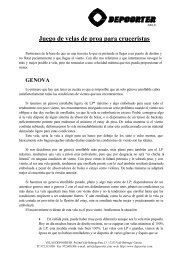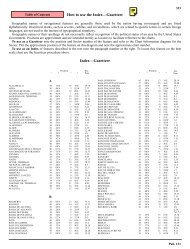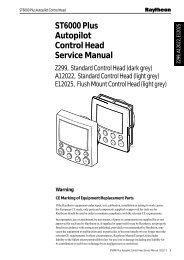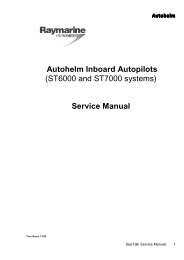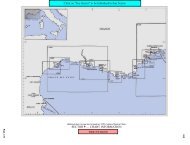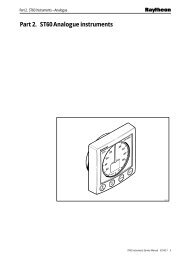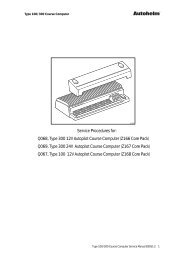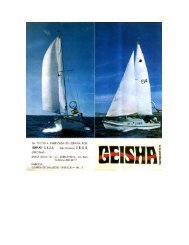Create successful ePaper yourself
Turn your PDF publications into a flip-book with our unique Google optimized e-Paper software.
41SECTOR 4CYPRUS4.0 Plan.—This sector describes Cyprus, the third largest islandin the Mediterranean. The general descriptive sequence is Sfrom Cape Arnauti, then E to Cape Greco, then NE to CapeAndreas, and finally W along the N coast.General Remarks4.1 Cyprus (35˚00'N., 33˚00'E.), one of the largestislands in the Mediterranean, has about 400 miles of coastline.The terrain consists of two mountainous areas which aredivided by a plain. This plain trends in a general E to W directionacross the N part of the island between Famagusta Bay andMorphou Bay. The greater part of the coast is backed bymountains. Olympus, the summit of the island, rises in the Whalf of the island.4.1 The principal ports include Famagusta, Limassol, Larnaca,and Kyrenia.4.1 Winds—Weather.—The Mediterranean climate of Cyprusis characterized by cool, rainy winters (November throughFebruary) and hot, dry summers (June through August). Thetwo transitional seasons, spring (March through May) andautumn (September through October), have few distinctiveweather characteristics of their own.4.1 On all coasts of Cyprus, a W wind is prevalent in summerand frequent in winter. On the S coast, E winds are as equallyfrequent as W winds in December and January, and S windstotal 30 per cent annually. On the N coast, E winds and Wwinds comprise over 50 per cent of the annual observations.On the E coast in summer, 25 per cent of the winds are fromthe E and 17 per cent are from the SW. Calms are infrequentbut are relatively more frequent on the E coast, Decemberthrough March. Most gales occur in winter. Gales are mostfrequent on the E coast. About 80 per cent of all wind speedsare 10 knots or less.4.1 There is very little fog; in late spring and summer it sometimesoccurs over the land in the first hour or two after sunrise.Sea fog begins to appear in April and attains a maximum inJune. Dense coastal fog lasting for about 2 hours near dawnoccurs at Larnarca 2 or 3 days a month in June and July. FartherW along the coast, reduced visibility occurs more frequentlybut is less intense. The N coast appears to be free fromserious restricted visibility.4.1 Tides—Currents.—The general current circulation aroundCyprus is part of the counterclockwise circulation of the Ebasin of the Mediterranean. The speed seldom exceeds 1 knot,and then only during strong W winds. During summer, thecurrent off the N coast of Cyprus sometimes sets E with avelocity of 0.5 to 1 knot, increasing to 2 knots with strong Wwinds. During the same season, the currents off the W and Scoasts of Cyprus may set E at 0.5 to 0.8 knot.4.1 Haze appears over the sea in summer. It is typically an earlymorning occurrence, but in some cases it lasts all day. Summernights are clear with good visibility.4.1 Caution.—Submarines frequently exercise in the watersaround Cyprus.4.1 Marine farms may lie close off the shores of the island inplaces and are generally marked by lighted buoys.West Coast4.2 Cape Arnauti (35˚06'N., 32˚17'E.), the NW extremityof Cyprus, is a low headland. It rises inland to a moderatelyhigh mountain range which extends SSE for 16 miles. A prominentbuilding, in ruins, stands on a hill with a double peak 1mile S of the cape. Mazaki Islet lies 0.4 mile N of the cape atthe extremity of a rocky ledge. A stranded wreck was reportedto lie close NE of the cape.4.2 Paphos Point (34˚45'N., 32˚24'E.), the extremity of a lowpeninsula, is fronted by a stranded wreck. A main light isshown from a prominent structure, 20m high, standing 0.5 mileNE of its seaward extremity.4.2 Except in very calm weather, the sea breaks constantly onthe reefs and rocky ledges which front the coast between CapeArnauti and this point.4.2 Paphos (34˚45'N., 32˚24'E.) (World Port Index No. 44940),a small harbor, lies on the S side of Paphos Point and is formedby two moles. It is used by small craft up to 18m in length and2m draft, and is no longer used for commercial purposes.4.2 From seaward, several tall chimneys; a water tower; and achurch, with a prominent dome, stand in the town and are allconspicuous. The entrance channel is indicated by a lightedrange which may best be seen on the chart. Anchorage can betaken, in a depth 26m, sand and shell, about 0.6 mile SSW ofthe harbor, but this berth is exposed to W and S winds and haspoor holding ground.4.2 Moulia Rocks, consisting of two rocky shoals, have depthsof less than 5m. They lie 2 miles SE of Paphos and extend upto 1.2 miles offshore. Several above-water rocks lie on the Eshoal. During summer, anchorage can be taken, in a depth of12m, sand and mud, good holding ground, about 0.3 mile E ofthese rocks. This roadstead is reported to be the best anchoragealong this section of the coast. The rocks are marked by a light.4.3 Cape Aspro (34˚38'N., 32˚42'E.), a bold and lightcoloredheadland, is formed by a line of cliffs which aredivided into three parts by two ravines. The land rises steeplyinland of the cape and attains a height of 276m at about 1 mile.4.3 Episkopi Bay (34˚37'N., 32˚50'E.) is entered between CapeAspro and Cape Zevghari, 12 miles SE. Several small sandybays lie along its N shore. The E part of this bay is backed byhigh white cliffs. Jubilee Shoal, with a least depth of 14.6m,lies 3.5 miles ESE of Cape Aspro. Cape Zevghari is fronted byrocks and two prominent stranded wrecks lie N of it. A conspicuoushospital building is situated on this cape.4.3 The village of Episkopi is situated in the NE part of the bayand can be identified by a conspicuous white church with a redroof. A prominent dome stands near the shore 2.5 miles W ofPub. 132





